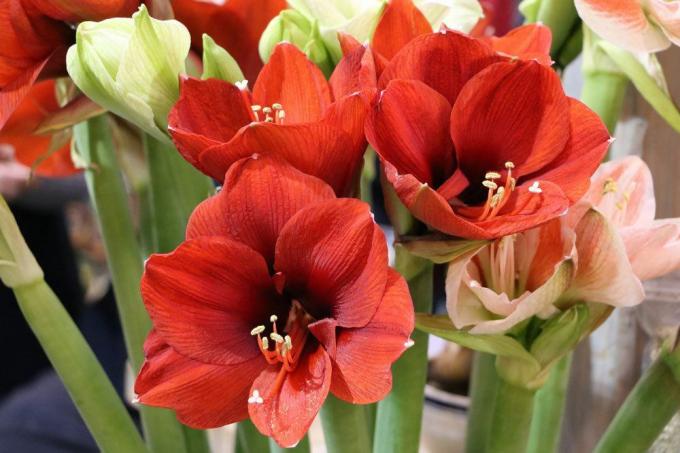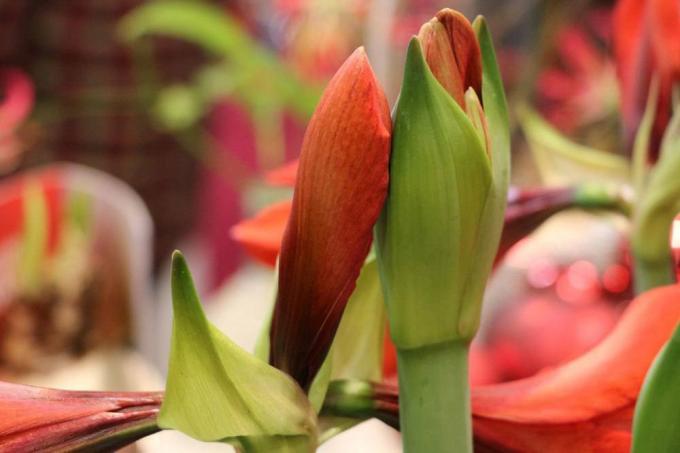
table of contents
- amaryllis
- Toxicity
- Symptoms of poisoning
- With people
- In animals
When the days get shorter in Central Europe and Christmas approaches, the amaryllis, which is very popular as a houseplant, opens its magnificent flowers. In view of this splendor, the question of toxicity cannot be dismissed out of hand, after all, beauty and toxic lethality often form an ominous alliance in nature. This also applies to the knight's star that can be found in many living rooms - only a few grams can be fatal after consumption.
amaryllis
Real amaryllis / Belladonna lily or knight star?
The term "Amaryllis" does not only stand for the different types of during the Winter months blooming genus Hippeastrum or Ritterstern, but also for the Belladonnalilie or Real amaryllis (Amaryllis belladonna). Both are popular houseplants and also belong to the same plant family Amaryllis family (Amaryllidaceae) and look very similar on the outside. However, the Belladonna lily comes from tropical South Africa and already blooms in autumn. The plant that shows its blooming splendor in many living rooms around Christmas time, on the other hand, is the knight's star, which comes from South America. With regard to their toxicity, however, there are no differences: Both plants, as well as the closely related daffodils and daffodils, contain highly poisonous
Amaryllidacean alkaloids.
Toxicity
Both amaryllis are deadly poisonous
The fascinatingly beautiful funnel-shaped flowers of both Hippeastrum and Belladonna lily deceive many lovers of the plant's extreme toxicity. In all parts of the plant are deadly poisonous Alkaloids with the highest concentration of poison manifesting itself in the onions. Mainly amelline and lycorine act on the nervous system, furthermore caranine as well as acetylcaranine and undulatin appear. A few grams of the plant are sufficient to keep it strong Symptoms of intoxication to evoke. To poison children dangerously, two to three grams of onion peel is enough. If there is a possibility that children can get to the plant, for example because it is on the windowsill in the living room, preference should be given to non-toxic indoor plants.
the Toxicity of these plants is shown, among other things, by the fact that extracts of the belladonna lily were used in earlier times as a highly effective arrow poison.
Symptoms of poisoning
With people
The ingredients of all amaryllis plants are toxic to cells, i. H. they damage body cells or even kill them. Typical physical reactions after poisoning are mainly the following.
- Drowsiness
- severe nausea
- Vomiting and diarrhea
- severe dizziness
- Racing heart
- Sweats
Furthermore, kidney problems and even kidney failure can occur, as the toxins attack the kidneys, among other things. In the worst case, the respiratory organs are paralyzed, causing poisoning due to Apnea can be fatal. For this reason, in severe cases, hospitals intubate the patient in the presence of amaryllis poisoning and provide artificial ventilation.

Proper first aid measures save lives
Under no circumstances should there be any signs of poisoning or If you suspect that your child has just eaten part of the amaryllis, vomiting will be caused! Vomit can get into the airways and cause additional shortness of breath. Children must also not be given salt water, as is sometimes recommended as a "home remedy" for poisoning or to induce vomiting. Larger amounts of table salt are also toxic to smaller children. Do not give the affected person any milk to drink, because the fat it contains only ensures that the fat-soluble Toxins are more easily absorbed through the intestines.
Instead, remove any that may still be in your mouth Plant parts and give that person a lot of clear, quiet water (if necessary from the line) to drink. See a doctor immediately. Let them know that the consumption of - possibly unknown - amounts of a highly poisonous amaryllis plant triggered the symptoms. If possible, bring the plant or parts of the plant with you. The local poison control center, which is located in all regions of Germany, can also help.
Avoid skin contact: sap is poisonous
Incidentally, the toxins of an amaryllis plant do not only have their harmful effects as a result of internal absorption. If the sap comes into contact with unprotected skin, there is a risk of unpleasantness Skin irritation and swelling and even inflammation. For this reason, you should always wear gloves when working with the amaryllis.
This is especially true when the withered leaves and flowers of the knight star are cut back! Besides, the cut ones are Plant parts Dispose of in such a way that children and pets cannot attack it. Disposal in the unsecured garbage can is therefore not sufficient - some curious toddlers or even dogs like to open the lid and see what is to be found underneath. It is better to pack the parts of the plant separately in a bag and immediately put it in the bag Household garbage can dispose. Compost is also not a suitable disposal site, as wild animals such as birds are also endangered here.
In animals
Effect on pets such as cats and dogs
Cats in particular have a tendency to nibble on indoor plants. Unlike wildlife, pets' natural instincts are severely underdeveloped. So cats and dogs eat plants or Parts of plants that are poisonous to them. The knight's star is potentially fatally poisonous not only to humans, but also to all pets. In particular, young cats and dogs as well as animals kept in apartments are at risk, as they are due to boredom, lack of experience and from curiosity try from the showy plant. For this reason, amaryllis plants have no place near pets either. It is best to cultivate the plant where your darlings have absolutely no access.

Symptoms of poisoning in animals and first aid measures
In domestic animals, the consumption of even a few parts of the knight's star can lead to cardiac arrhythmias, which can possibly cause cardiac arrest.
The following symptoms suggest poisoning:
- increased salivation
- Diarrhea and vomiting
- Drowsiness, staggering
- convulsions associated with tremors
If you suspect poisoning, bring the animal to the immediately vet respectively. to the nearest veterinary clinic and describe your suspicions. Include the name of the causative plant. Do not induce vomiting beforehand. Usually the affected animal can be helped quickly.



